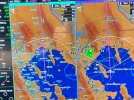chemgeek
En-Route
- Joined
- Dec 5, 2009
- Messages
- 3,111
- Display Name
Display name:
chemgeek
FYI, at 1800 UTC (the time of the accident) the Sidney (N23) AWOS was reporting heavy rain. Somehow, inexplicably, the accident aircraft apparently flew right into a scattered cell. During my IFR training (in the summer) I gained a tremendous respect for towering CU. Not CBs, just building CU with tops at 12000-14000 MSL. They can be a wild ride. Towering CU with moderate precip are definitely a no-go.
It was a weird weather day in Central NY. Some parts were severe clear, others had lines of scattered to isolated rain showers, some quite intense, due to a passing through of low pressure.
It was a weird weather day in Central NY. Some parts were severe clear, others had lines of scattered to isolated rain showers, some quite intense, due to a passing through of low pressure.


